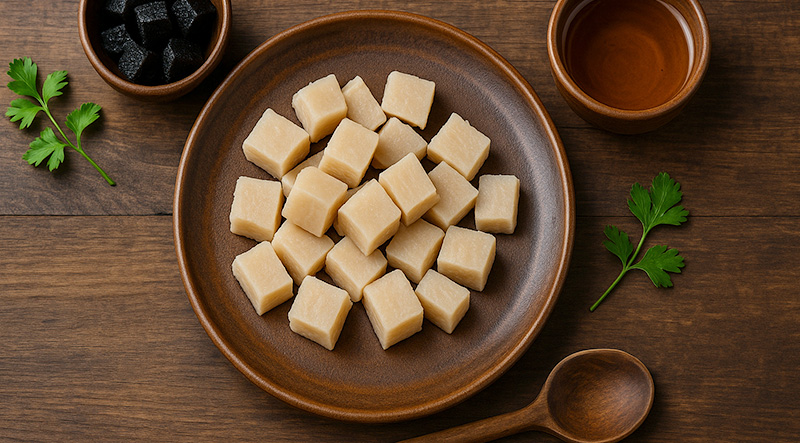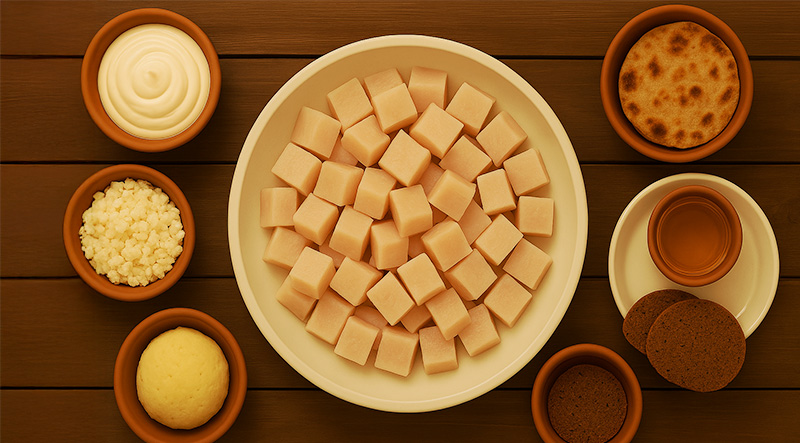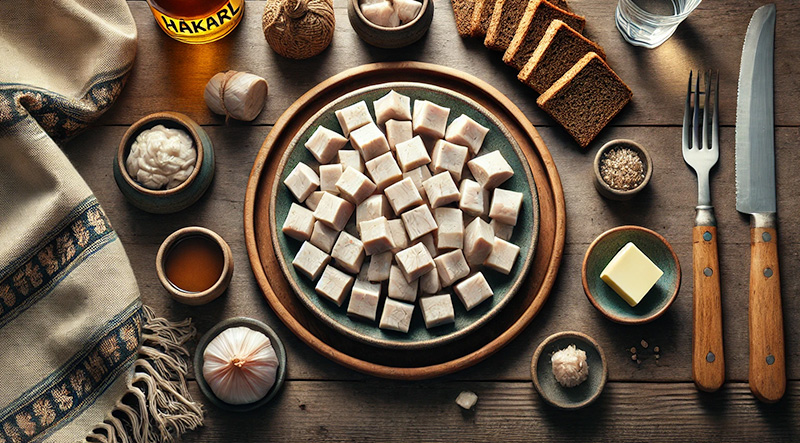Hákarl is not for the weak of palate, but for those who want a taste of the wild North, so get ready for a bold bite of Icelandic tradition. Under Iceland's volcanic soil, this fermented Greenland shark delicacy is aged and cured for months before being perfectly air-dried. Hákarl, which is typically served in tiny cubes with a shot of brennivín, Iceland's signature schnapps, is a culinary rite of passage due to its strong aroma and unmistakably sharp flavor. This dish, which offers a memorable taste of Iceland's untamed past, is rooted in Viking survival and contemporary curiosity. Read More...
Ancient Origins Rooted in Necessity:
Hákarl, Iceland’s infamous fermented shark, has its roots deep in the island’s Viking history. With limited resources and harsh living conditions, early Icelandic settlers had to find innovative ways to make use of every available food source. One such source was the Greenland shark, a massive predator native to the icy waters surrounding Iceland. However, this shark’s flesh is toxic when fresh due to high levels of urea and trimethylamine oxide. Traditional cooking methods were ineffective, forcing early Icelanders to develop a fermentation process that would render the meat safe—and eventually edible.
The Fermentation Process: From Poison to Provisions:
The traditional preparation of Hákarl began with gutting and beheading the shark before burying it in a shallow gravel pit. Stones were then placed on top to press out fluids, and the meat was left to ferment for 6 to 12 weeks. After fermentation, the shark was unearthed, hung to dry in open-air sheds, and aged for several more months. This process removed the harmful substances and developed the dish’s trademark ammonia-rich aroma and chewy texture. Though modern methods have shortened and sanitized the process, the pungent taste remains largely unchanged.
Cultural Significance and Seasonal Celebrations:
While Hákarl was once a survival food, it eventually gained ceremonial importance. Today, it is most commonly consumed during Þorrablót, an annual midwinter festival celebrating Icelandic heritage. Served alongside other traditional foods such as sheep’s head, blood pudding, and rye bread, Hákarl acts as a symbol of Icelanders’ resilience and resourcefulness. Locals and curious tourists alike often sample the shark with a shot of brennivín—a potent Icelandic schnapps affectionately nicknamed “Black Death.”
A Taste of the Past That Endures:
Though not part of the average Icelander’s daily menu, Hákarl remains a proud cultural icon. For some, it’s a delicacy; for others, a dare. But whether it’s met with reverence or revulsion, Hákarl tells the story of an island people who turned necessity into tradition. Through generations, this once-essential survival food has transformed into a unique culinary artifact, one that continues to challenge and intrigue the adventurous palate.
Traditional Recipe for Hákarl (Fermented Greenland Shark):
Butchering the Shark:

Fermentation Phase:
Check for Readiness:

Drying Phase:
Trimming and Slicing:

Serving Tip:
The preparation of Hákarl is an extensive, traditional process that takes several months. First, the Greenland shark meat is cleaned, then buried in gravelly sand and pressed with stones for 6 to 12 weeks to allow toxic compounds to ferment and leach out. After fermentation, the meat is hung to dry in open-air sheds for 2 to 4 months, during which it develops its distinct aroma and texture. There is no cooking involved in this preservation method. In total, the full preparation process typically spans 4 to 6 months before the Hákarl is ready to be sliced and served in small cubes. If you're serving pre-prepared Hákarl (purchased from a certified Icelandic producer), the preparation time is minimal. It takes about 5 to 10 minutes to portion and serve. The shark is typically cut into small bite-sized cubes and served chilled, often accompanied by rye bread or a shot of Brennivín (Icelandic schnapps). No cooking or additional preparation is needed—just slice, plate, and serve.
A single serving of Hákarl (about 30 grams or a small portion of cubed fermented shark) contains approximately 100–120 calories, primarily from protein and a small amount of fat. Since the preparation involves fermentation and drying without added ingredients like oil or sauces, the calorie count remains relatively low. It is also high in sodium due to the preservation process, but low in carbohydrates. While not typically consumed in large quantities, Hákarl serves more as a traditional tasting portion or cultural experience rather than a full meal.







